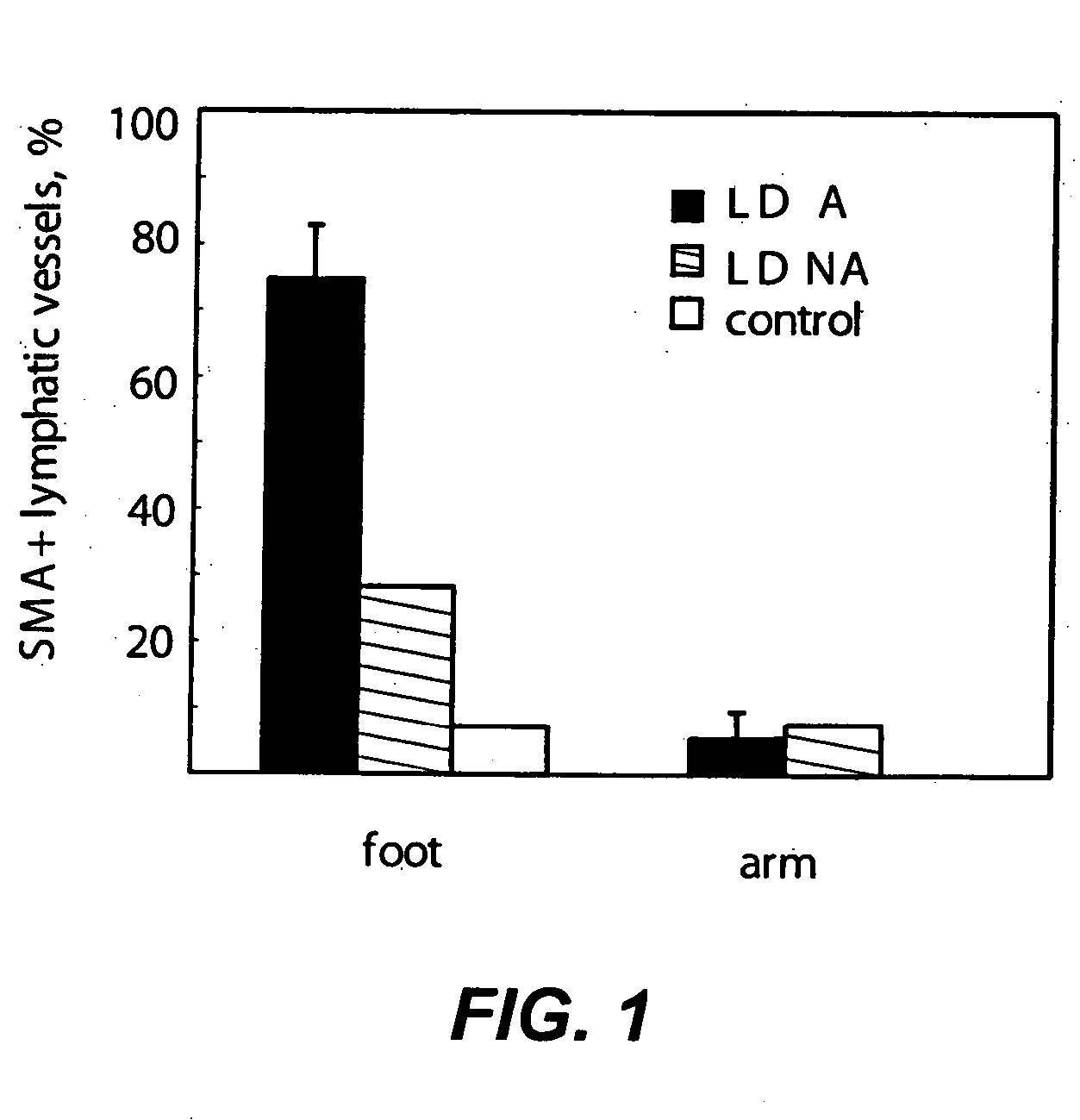Compositions and methods for treatment of lymphatic and venous vessel arterialization
a technology for venous arterialization and compositions, which is applied in the direction of viruses, peptide/protein ingredients, dna/rna fragmentation, etc., can solve the problems of increasing the risk of developing cancer, physical impairment and social anxiety, and chronic, potentially life-threatening infections of the lower extremities, so as to reduce or prevent venous backflow in the blood vessel and improve venous function.
- Summary
- Abstract
- Description
- Claims
- Application Information
AI Technical Summary
Benefits of technology
Problems solved by technology
Method used
Image
Examples
example 1
[0446] Mice heterozygous for Foxc2 and the lymphatic endothelial receptor VEGFR-3 display abnormal lymphatic vascular patterning and increased pericyte / smooth muscle cell investment of lymphatic capillaries. Such mice are administered therapeutic agents described herein at varying doses and combinations, and evaluated for lymphatic flow or backflow or edema before and after treatment. Tissue samples are evaluated before and after treatment for general appearance and density of lymphatic vessels and for amount of SMC investment in the lymphatic capillaries and for PDGF and PDGFR expression.
[0447] Additional procedures for determining the effects of the therapy include lymphoscintigraphy. In such analyses, a Tc-99m filtered colloid, at a dose of 50 μCi, is injected into the tail vein, ear or other site of the animal at which a swollen phenotype is observable. Imaging of the injection is performed using a large field-of-view Genesys γ camera (ADAC Laboratories, Milpitas, Calif., USA)....
example 2
[0455] The following example describes an exemplary procedure for transforming endothelial cells with a FoxC2 gene therapy construct and evaluating gene expression in such cells.
[0456] Human primary coronary artery, saphenous vein, human umbilical vein endothelial cells, and microvascular endothelial cells are commercially obtainable, e.g., from Promocell. Lymphatic endothelial cells may be isolated and cultured as described previously in Makinen, T. et al., “Isolated lymphatic endothelial cells transduce growth, survival and migratory signals via the VEGF-C / D receptor VEGFR-3,” Embo J 20, 4762-73. (2001), and are more than 98% pure as determined by staining for lymphatic endothelial markers podoplanin. See also U.S. patent application Ser. No. 10 / 483,203, filed Jan. 7, 2004 and International Patent Application No. PCT / US02 / 22164, filed 12 Jul. 2002 and published as WO 03 / 006104, all incorporated herein by reference.
[0457] In another variation, endothelial cells or other cells fro...
example 3
Ex-Vivo Cell Stimulation and Gene Therapy for Lymphedema with FoxC2 Gene-Transfected Cells
[0461] Endothelial cells or endothelial precursor cells from a laboratory animal or a human diagnosed with lymphedema distichiasis and a FoxC2 mutation are isolated and transfected with a gene therapy construct to introduce a functional (e.g, a wildtype) FoxC2 gene. The cells optionally are cultured to expand them and then are readministered to the affected animal or human from which they were obtained, in numbers effective numbers to promote improved lymphatic function in vivo. In preferred embodiments, the manipulated cells are autologous cells, but in another variation, the cells are from a donor or derived from stem cells of the same species. The cells are delivered by one or more administrations, e.g., by injection in a region of the body with edema.
[0462] In a related variation, the procedure is performed on a genetically affected individual before the onset of lymphedema symptoms, for...
PUM
| Property | Measurement | Unit |
|---|---|---|
| molecular weight | aaaaa | aaaaa |
| molecular weight | aaaaa | aaaaa |
| molecular weight | aaaaa | aaaaa |
Abstract
Description
Claims
Application Information
 Login to View More
Login to View More - R&D
- Intellectual Property
- Life Sciences
- Materials
- Tech Scout
- Unparalleled Data Quality
- Higher Quality Content
- 60% Fewer Hallucinations
Browse by: Latest US Patents, China's latest patents, Technical Efficacy Thesaurus, Application Domain, Technology Topic, Popular Technical Reports.
© 2025 PatSnap. All rights reserved.Legal|Privacy policy|Modern Slavery Act Transparency Statement|Sitemap|About US| Contact US: help@patsnap.com

